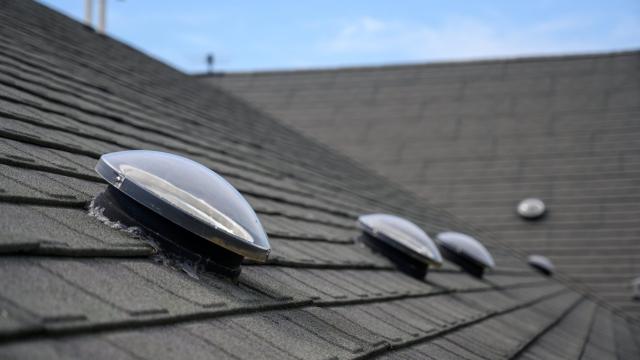Letting in some natural light can really brighten up your home, especially during the winter months. However, while traditional skylights are an option, they can be costly and add to heating and cooling costs. Tubular skylights are a good alternative, providing natural light year round without losing as much insulation as a traditional skylight.
How tubular skylights bring the sunshine indoors
Tubular skylights are a great alternative for hallways, stairwells, closets, and attics when you’re considering adding a natural light source. They come in different configurations that can go from two to 12 metres from the roof. When installed, a tubular skylight — also known as a solar tube — looks like a small dome on your roof. The dome is designed to concentrate and reflect as much light as possible toward the tube. Indoors, the end of the tube will look like a recessed lighting fixture; in between the visible parts, the tube is coated with reflective material to maximise the available light. The fixture allows daylight into your home with no need for electricity.
Why tubular skylights are efficient and practical
In addition to saving on energy costs and providing natural light, solar tubes aren’t as prone to leaking as regular skylights when installed correctly. They don’t need to be wired into an electrical source, so you can put them in without adding circuits to your electrical service. This means that tubular skylights are lower cost to install and can also save significantly on maintenance and energy costs over time.
Things to keep in mind
There are some important things to keep in mind when considering tubular skylights. First, they don’t provide the spectacular view a regular skylight would. Second, just like with a traditional skylight, solar tubes will dim when the light outside dims, so they aren’t recommended as the only light source. However, there are more high-end models that come with LED inserts and sensors to accommodate darkness — this type can provide 24 hours of lighting and still significantly cut energy costs. A solar powered, remote controlled, dimmable model solar tube is an option if you don’t want the full brightness of sunlight during all daylight hours.
The drawbacks of tubular skylights
The drawbacks to tubular skylights are, of course, that they don’t work in the dark, and they only have one power source (the sun). This type of solar lighting isn’t practical in places where it’s dark for more hours than it’s light in the winter season. In addition, each tube will show up as a little dome on top of your roof. If you don’t like the look of the domes, solar tubes probably aren’t for you.
When to hire a professional
If you like the idea of solar tubes, it is possible to install them yourself. However, this process involves cutting a hole in your roof, so it’s not a beginner project. If you do decide to tackle it anyway, make sure to choose a tube that fits the space you have, and it’s essential to choose a kit that comes with flashing so it doesn’t leak.
Make sure to read the manufacturer instructions carefully, as incorrect installation could result in damage to your home. If you’re not comfortable climbing out onto your roof safely, or if you’re a DIY beginner, this is a project for a pro.

Leave a Reply
You must be logged in to post a comment.